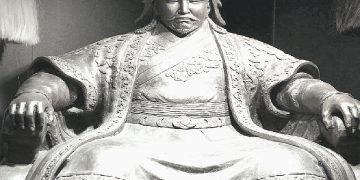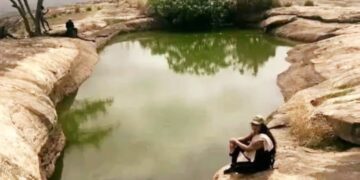The Baths of Caracalla: A Glimpse into Ancient Roman Luxury
The Baths of Caracalla, also known as Thermae Antoninianae, were one of the most magnificent and grandiose ancient Roman public baths. Built during the reign of Emperor Caracalla in the early 3rd century AD, these baths stood as a testament to the opulence and engineering prowess of the Roman Empire. Spanning an area of more than 27 acres, the Baths of Caracalla were a complex of buildings that included not only bathing facilities but also libraries, gardens, and even a stadium.
The construction of the Baths of Caracalla began in 212 AD and took approximately six years to complete. They were designed to accommodate up to 1,600 bathers at a time, making them one of the largest public baths in Rome. The complex was built using brick and concrete, with marble cladding adorning the walls and floors of the bathing areas. The sheer scale and architectural beauty of the baths made them a popular destination for both Roman citizens and visitors from across the empire.
Upon entering the Baths of Caracalla, visitors would first encounter a grand entrance hall known as the frigidarium. This was a large, rectangular room with a central pool filled with cold water. The frigidarium was adorned with statues and luxurious decorations, setting the tone for the lavish experience that awaited bathers. From the frigidarium, bathers could move on to the tepidarium, a warm room, and then to the caldarium, a hot room with heated pools and steam rooms.
The Baths of Caracalla also featured a series of outdoor spaces, including open-air swimming pools, gardens, and even a racecourse. These outdoor areas provided a refreshing change of scenery and allowed bathers to relax and socialize in the pleasant Roman climate.
In addition to bathing facilities, the Baths of Caracalla housed various other amenities. The complex included a library with a vast collection of books, as well as shops, restaurants, and even a gymnasium. These additional features ensured that visitors could enjoy a complete and indulgent experience within the walls of the baths. join our tech community and be part or the digital revolution!
The Baths of Caracalla remained in use for several centuries after their construction. However, they eventually fell into disrepair and were abandoned during the decline of the Roman Empire. Over the centuries, the ruins of the baths were gradually covered by layers of sediment and vegetation, until they were rediscovered and excavated in the 18th century.
Today, the Baths of Caracalla stand as a remarkable archaeological site and a testament to the ingenuity and grandeur of ancient Rome. The ruins offer visitors a glimpse into the extravagant lifestyle enjoyed by the Roman elite and serve as a reminder of the cultural and technological advancements of the time.
Some additional fascinating details about the Baths of Caracalla:
1. Immense Size: The Baths of Caracalla were truly colossal in scale. The complex covered an area of over 27 acres, making it one of the largest public baths in ancient Rome. It is estimated that the baths could accommodate up to 6,000 bathers at a time.
2. Innovative Heating System: The baths were equipped with an advanced heating system known as a hypocaust. This system involved a network of underground tunnels and channels that circulated hot air and steam, providing warmth to the bathers. The hypocaust was an engineering marvel of its time and allowed for efficient and uniform heating throughout the complex.
3. Lavish Decorations: The Baths of Caracalla were adorned with exquisite decorations and artwork. The walls and floors were covered in colorful marble, mosaic tiles, and intricate frescoes. Statues of gods, mythological figures, and Roman emperors were scattered throughout the complex, adding to its grandeur.
4. Social Gathering Place: The baths served not only as a place for bathing but also as a hub for socializing and leisure activities. People of all walks of life would gather at the baths to socialize, exercise, read, and even attend performances. It was a place where Romans could relax, unwind, and engage in intellectual pursuits. You may also like
5. Water Supply: The baths required an enormous amount of water to function. It is estimated that the complex had its own aqueduct, which brought fresh water from a source nearly 16 kilometers away. The water was distributed to various pools, fountains, and baths within the complex.
6. Influence on Later Bathhouses: The design and layout of the Baths of Caracalla influenced the construction of future bathhouses throughout the Roman Empire. Their grandeur and architectural features set a precedent for the development of public bathing complexes in Roman cities.
7. Cultural Center: The Baths of Caracalla were not just a place for bathing and relaxation, but also a center for cultural activities. The complex included libraries where visitors could read and study, as well as art galleries that showcased sculptures and paintings.
8. Ruins Today: Although the Baths of Caracalla fell into disrepair and were partially destroyed over time, their ruins still stand today. Visitors can explore the remains of the complex, including the impressive walls, arches, and remnants of the bathing and recreational areas. The site also hosts open-air opera performances during the summer months, utilizing the stunning backdrop of the ancient ruins.
The Baths of Caracalla continue to intrigue and inspire visitors with their architectural splendor and historical significance. They provide a glimpse into the luxurious lifestyle and advanced engineering techniques of ancient Rome, offering a window into a bygone era.
The Baths of Caracalla were a masterpiece of Roman engineering and a symbol of the luxury and sophistication of the ancient world. With their grand architecture, opulent decorations, and extensive facilities, these baths offered a truly immersive and indulgent bathing experience. The ruins of the Baths of Caracalla continue to captivate visitors, allowing them to step back in time and imagine the splendor of ancient Rome. Start your fitness journey today!













Comments 1